U.S. Department of Transportation
Federal Highway Administration
1200 New Jersey Avenue, SE
Washington, DC 20590
202-366-4000

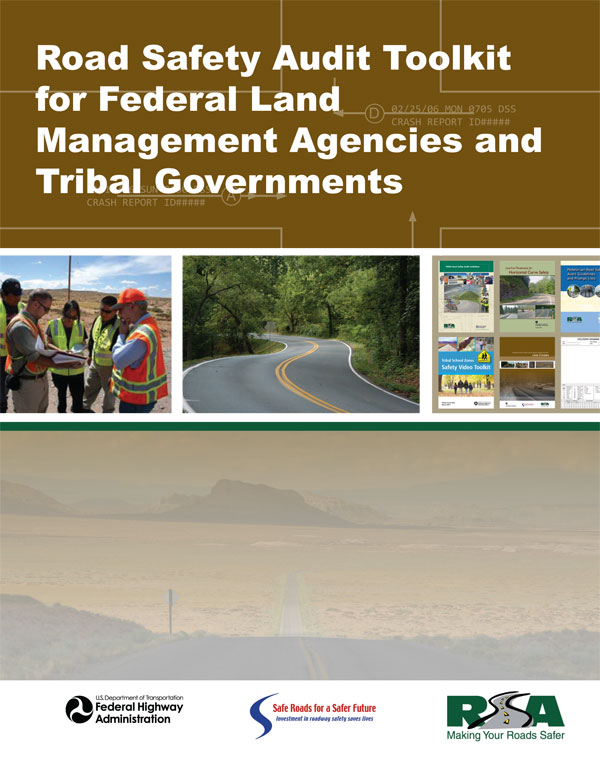
This section includes resources that may be helpful in establishing an RSA program, conducting RSAs, and identifying potential improvements. Sample materials that can be used to conduct and document RSAs are also provided.
The following is a general outline of a Request for Proposal (RFP) for an RSA. For each section, a brief explanation of the information to be included in the RFP is provided. The RFP generally follows the 8-step RSA process, however, the requesting agency may wish to include additional tasks or eliminate tasks based on specific needs. Federal Land Management Agencies and Tribes may draft and issue a request for engineering consultant services to lead one or a series of RSAs on their lands. Typically, RFPs generate responses from several consultants and requires the issuing agency to award a contract based on the consultant’s ability to adequately perform the work and the cost at which the work can be completed.
PROJECT DESCRIPTION: Provide a brief overview of the Consultant’s responsibilities, a brief description of the RSA, and how the RSA will be conducted.
ANTICIPATED SERVICE START AND END DATES: Identify start and end date of services.
PREQUALIFICATION CLASSIFICATION: Identify any stipulations to establish the type(s) of work the Consultant must be qualified to perform.
DBE REQUIREMENT: Identify any Disadvantaged Business Enterprise (DBE) requirement(s) the Consultant must satisfy to be eligible for consideration for award of contract.
PROJECT MANAGER: Provide the name and contact information of the person(s) overseeing the execution of the scope of services. This person is typically from the requesting agency.
GENERAL BACKGROUND: Provide a brief description of the purpose and objective of the services being requested.
OBJECTIVES AND TASKS OF THE PROPSED PROJECT: Provide a detailed task-by-task description of the work to be completed to meet the purpose and objective of the services being requested.
Identify Multidisciplinary RSA Team (Optional: can be completed by owning agency as described in Chapter 1).
Prepare Relevant Data and Documents
Conduct RSA Briefing Meeting
Perform Field Reviews
Conduct Debriefing Meeting
Prepare Draft RSA Findings Report
Conduct Cost Analysis
Present Draft RSA Findings Report
Submit Final RSA Findings Report
CONSULTANT RESPONSIBILITIES: Provide details of the Consultant’s contractual responsibilities to fulfill the scope of services being requested. This may include principal contacts, materials and equipment, funding compliance, personnel, and progress reporting.
HOST AGENCY RESPONSIBILITIES: Provide details of the hosting agency’s responsibilities to the Consultant to fulfill the scope of services being requested. This may include provision of documentation, transportation, and any relevant information needed for the RSA.
PAYMENT SCHEDULE: Provide information with regard to how the Consultant will be compensated for completing the scope of the services being requested. Also establish a billing schedule and other terms and conditions of compensation.
The following is an example of an application to request assistance to conduct an RSA. This may be used when requesting an RSA on a roadway adjacent to Federal or tribal lands which is owned by a State or local DOT. Applications such as this are used by agencies that have a formal RSA request process in place; however, the information in the application may be included in any type of correspondence to an owning agency (State or local agency) to request an RSA.
ROAD SAFETY ASSESSMENT APPLICATION
The agenda helps set the course of events for the RSA process. In addition to setting a time schedule, it also provides direction to all parties involved as to who should partake in the various activities. The agenda is created by the RSA team and provided to all participating parties prior to the RSA.
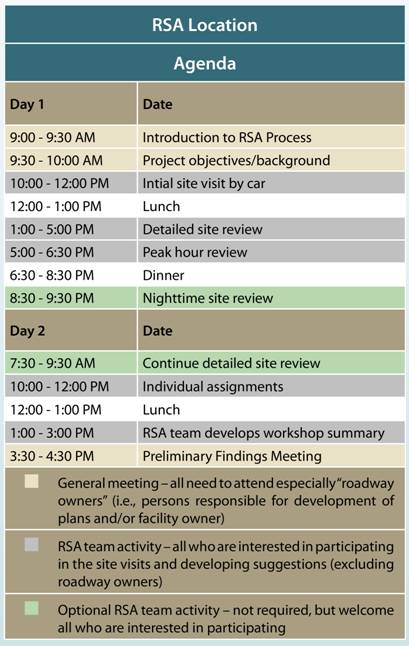
The following data elements are typically requested for conducting RSAs. Those data elements that are most important are notated with an asterisk (*). The data is requested prior to conducting the RSA so that the team has an opportunity to review and become familiar with the characteristics of the study area. Depending on the extent of the data provided, summary tables and graphics may be created to make the information more manageable for field review activities and presentation purposes. It is recognized that this data may not be available, but lack of data does not prevent an RSA from being conducted.
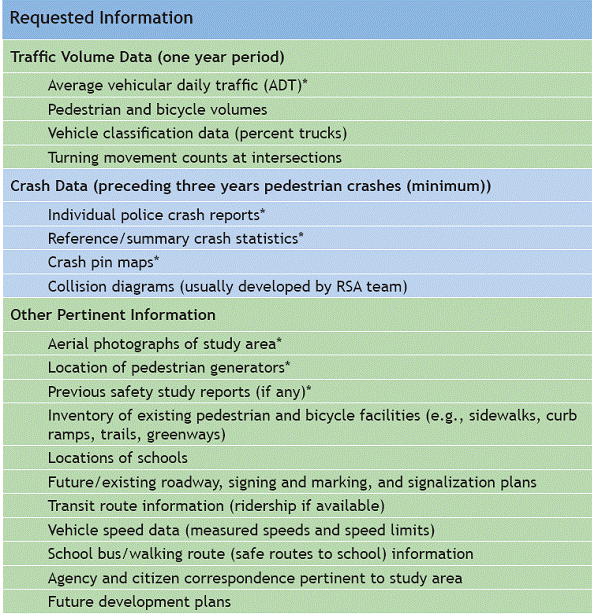
Collision diagrams use symbols to illustrate the location of crashes by crash type. The diagrams help the RSA team to identify patterns in crashes. Information provided on the collision diagram may include time of day, day of the week, light conditions, weather conditions, surface conditions, and severity level. Corresponding document numbers may also be included as a reference to a detailed crash report. Collision diagrams may be obtained from the owning agency (if available) or may be produced by the RSA team if crash reports are provided. Ideally, the diagrams should be obtained or produced prior to the start-up meeting (Step 3 of the RSA process).
The example collision diagram demonstrates how crashes can be illustrated:
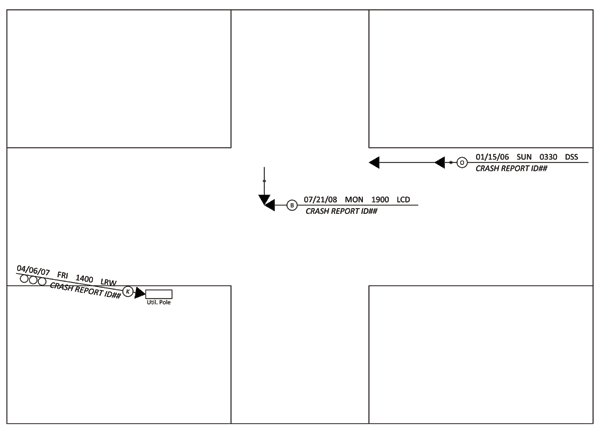
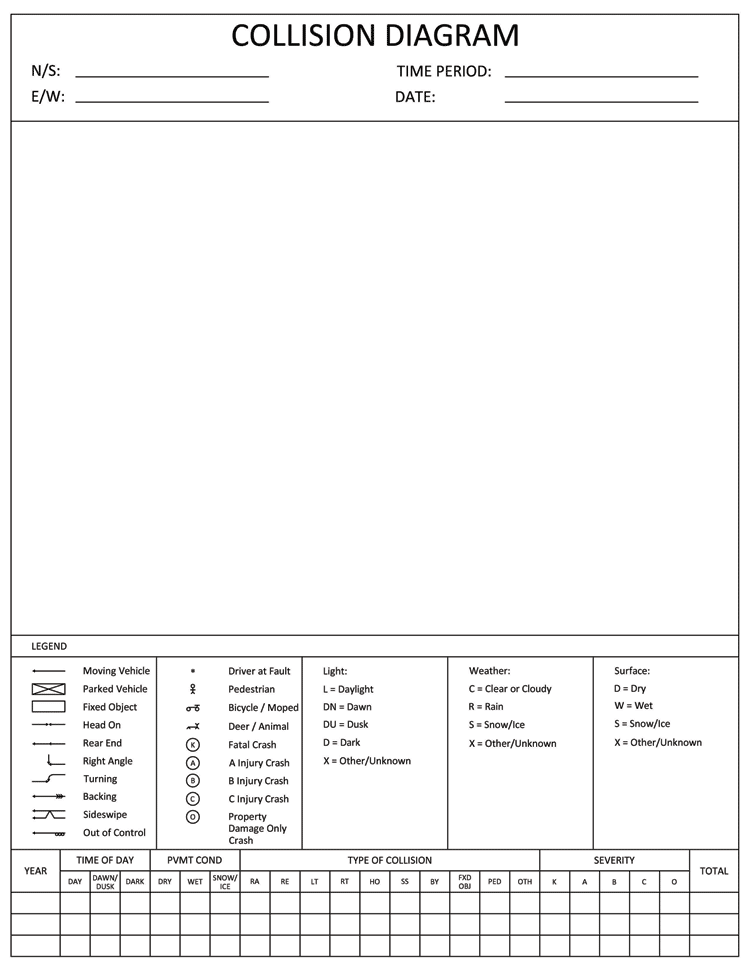
Documenting potential safety issues is an important part of the RSA field review process. The notes taken by the RSA team in the field are used to conduct the RSA analysis and prepare the findings report. In addition to field notes, an aerial photo can be useful to annotate issues and comments, rather than sketching the location by hand. Photographs (and video recordings, if desired) of identified safety issues should also be taken as a further means of documentation. This worksheet is intended to be used during Step 4 of the RSA process.
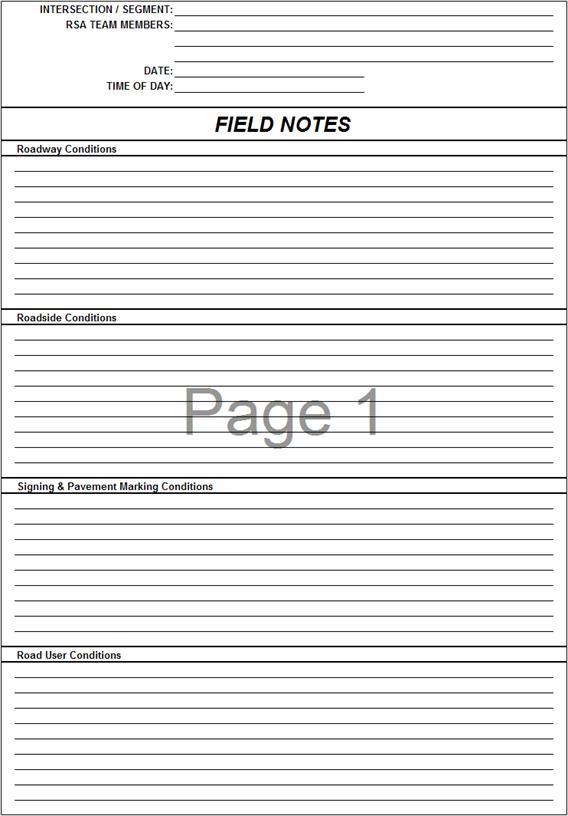
The following list provides a number of possible materials that could be taken by an RSA team member into the field when conducting reviews. Not all of the materials on this list are absolutely necessary, but should be strongly considered. Any other materials that do not appear on this list but are thought to be essential to the field review should be included.
The following provides a general framework of the components and structure of a RSA report.
The following examples illustrate different methods of presenting the safety issues and proposed suggestions discovered and developed during the RSA. This information would appear in Section 4 “Assessment Findings” of the sample report outline.
Example 1: Portrait Layout (Two-Column Format)
| Issue 2: Roadside Hazards
2.1 Fixed objects near roadway: There are several fixed objects along the corridor in close proximity to the roadway, particularly within curves. Fixed objects along the corridor include trees, utility poles, embankments, and culverts. Based on crash data from 2006 to 2008, 30 of the 47 crashes along the corridor were run-off-road, 18 of which involved a fixed object. Of the 18 fixed object crashes, seven involved a tree, six involved a utility pole, and five involved an embankment. Suggestions: Intermediate – Consider removing trees and other fixed objects that are within the clear zone, particularly along the outside of curves. Long-term – Consider relocating utility poles to the inside of horizontal curves, where they are less likely to be struck. Consider increasing the pavement width to create a consistent cross-section and provide more room for recovery. |
|
Example 2: Landscape Layout (Three-Column Format)
| Primary Issue: Animals on the Roadway | ||
|---|---|---|
Specific Safety Concern |
Suggested Improvements |
Example of Issue |
Animals—the roadside throughout the study area is open range. Horses, cows, and sheep were observed crossing and grazing along the roadway during daytime and nighttime conditions. Animal-related crashes represented approximately 25% of all crashes along the corridor. |
Short-Term – Utilize reflective ear tags, branding, or other strategies to increase the conspicuity of animals at night. Intermediate – Consider installing an animal fence along the corridor. This may be a challenge as the County does not provide any right of way fencing on county roads. This may require coordinating with the grazing official to support the effort. Long-Term
|
|
The Road Safety Audit (RSA) software is a tool for assisting with the completion of RSAs. The software facilitates team members in the collection of information as they proceed through the RSA process. It gives users access to comprehensive prompt lists and reduces the potential for users to simply “check” issues off a list. The prompt lists are presented at different levels of detail, helping users to identify issues that may be overlooked in the RSA process. With the software, users can link identified issues to user-defined locations in the study area and provide accompanying comments with each issue. It also allows users to record suggestions for improvements that may be identified. Finally, output from the RSA software groups findings by issue and exports the results to a Word-compatible file that allows for quick completion of a formal RSA report. The software is available for download on FHWA’s Office of Safety website.
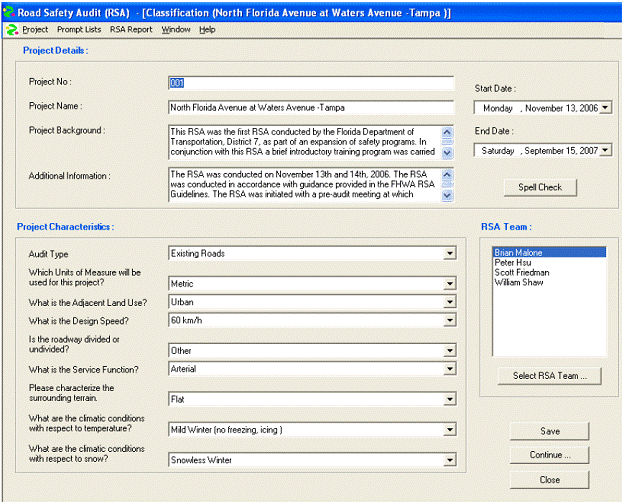
Road Safety Audits: Case Studies (FHWA-SA-06-17), March 2007
http://safety.fhwa.dot.gov/rsa/case_studies/fhwasa06017/fhwasa06017.pdf
Tribal Road Safety Audits: Case Studies (FHWA-SA-08-005), September 2008
http://safety.fhwa.dot.gov/rsa/tribal_rsa_studies/tribal_rsa_studies.pdf
Federal and Tribal Lands Road Safety Audits: Case Studies (FHWA-FLH-10-05), December 2009
http://flh.fhwa.dot.gov/programs/irr/safety/documents/trsa-case-studies-2.pdf
Recent Uses of Road Safety Audits (RSAs) in Highway Safety Improvement Programs and Strategic Highway Safety Plans (TRB Paper 09-2492)
TRB 88th Annual Meeting Compendium of Papers DVD
Selected Examples of Tribal Road Safety Audits (RSAs) in the United States (TRB Paper 10-1284)
TRB 89th Annual Meeting Compendium of Papers DVD
FHWA Road Safety Audit Guidelines (FHWA-SA-06-06), 2006
http://safety.fhwa.dot.gov/rsa/guidelines/documents/FHWA_SA_06_06.pdf
Pedestrian Road Safety Audit Guidelines and Prompt Lists (FHWA-SA-07-007), July 2007
http://drusilla.hsrc.unc.edu/cms/downloads/PedRSA.reduced.pdf
Road Safety Audits/Assessments Training Course (FHWA-NHI-380069)
http://www.nhi.fhwa.dot.gov/training/nhistoresearchresults.aspx?topicnum=380
usRAP
http://www.usrap.us/home/
Roadway Safety Tools for Local Agencies (NCHRP Synthesis 321)
http://onlinepubs.trb.org/onlinepubs/nchrp/nchrp_syn_321.pdf
SAFER Manual, Transportation Information Center, University of Madison-Wisconsin, 1996
http://epdfiles.engr.wisc.edu/pdf_web_files/tic/other/SAFER_96.pdf
NCHRP Report 500: Guidance for Implementation of the AASHTO Strategic Highway Safety Plan Transportation Research
http://www.trb.org/Main/Public/Blurbs/152868.aspx
NCHRP Report 622: Effectiveness of Behavioral Highway Safety Countermeasures
http://onlinepubs.trb.org/onlinepubs/nchrp/nchrp_rpt_622.pdf
Sign Retroreflectivity Manual: How to Meet the New National Standard for Small Agencies, Federal Land Management Agencies, and Tribal Governments (FHWA-CFL/TD-09-005), July 2009
http://safety.fhwa.dot.gov/roadway_dept/night_visib/retrotoolkit/
Roadway Safety Guide, Roadway Safety Foundation
http://www.roadwaysafety.org/wp-content/uploads/guide3.pdf
Vegetation Control for Safety (FHWA-SA-07-018), May 2007 [Revised August 2008]
http://safety.fhwa.dot.gov/local_rural/training/fhwasa07018/
Maintenance of Signs and Sign Supports (FHWA-SA-09-025), January 2010
http://safety.fhwa.dot.gov/local_rural/training/fhwasa09025/fhwasa09025.pdf
W-Beam Guardrail Repair (FHWA-SA-08-002), November 2008
http://safety.fhwa.dot.gov/local_rural/training/fhwasa08002/fhwasa08002.pdf
Maintenance of Drainage Features for Safety (FHWA-SA-09-024), July 2009
http://safety.fhwa.dot.gov/local_rural/training/fhwasa09024/fhwasa09024.pdf
Roadway Delineation Practices Handbook (FHWA-SA-93-001), August 1994
https://www.fhwa.dot.gov/tfhrc/safety/pubs/93001/93001.pdf
Good Practices: Incorporating Safety into Resurfacing and Restoration Projects (FHWA-SA-07-001), December 2006
http://safety.fhwa.dot.gov/roadway_dept/strat_approach/fhwasa07001/fhwasa07001.pdf
Mitigation Strategies for Design Exceptions (FHWA-SA-07-011), July 2007
http://www.wsdot.wa.gov/publications/fulltext/ProjectDev/Manuals/MitigationManual.pdf
Low-Cost Treatments for Horizontal Curve Safety (FHWA-SA-07-002), December 2006
http://safety.fhwa.dot.gov/roadway_dept/horicurves/fhwasa07002/fhwasa07002.pdf
National Scan of Best Practices for Chemical Treatments on Unpaved Roads
http://www.roaddustinstitute.org/scantour/default.aspx
FHWA CMF Clearinghouse
http://www.cmfclearinghouse.org
Crash Cost Estimates by Maximum Police-Reported Injury Severity Within Selected Crash Geometries
https://www.fhwa.dot.gov/publications/research/safety/05051/05051.pdf
A Primer on Safety Performance Measures for the Transportation Planning Process (FHWA-HEP-09-043), September 2009
http://safety.fhwa.dot.gov/hsip/tsp/fhwahep09043/fhwahep09043.pdf
Tribal Highway Safety Plans
http://flh.fhwa.dot.gov/programs/irr/safety/sms.htm
Tribal Transportation Programs (NCHRP Synthesis 366)
http://onlinepubs.trb.org/onlinepubs/nchrp/nchrp_syn_366.pdf
Considering Safety in the Transportation Planning Process
http://tmip.fhwa.dot.gov/resources/clearinghouse/docs/safety/safety.pdf
Incorporating Safety into Long-Range Transportation Planning (NCHRP Report 546), 2006
http://tmip.fhwa.dot.gov/resources/clearinghouse/docs/safety/safety.pdf
Transit Planning Guidebook for FLMAs
http://flh.fhwa.dot.gov/programs/planning.htm
Tribal Transportation Planning Guide for Washington State
http://www.wsdot.wa.gov/NR/rdonlyres/D9668173-F25F-448B-B571-57EB32122036/0/TribalTransportationPlanningGuideforWashingtonState.pdf
Page, M. A. “A Toolkit for Reducing Wildlife & Domestic Animal-Vehicle Collisions in Utah”. TRB 2006 Annual Meeting CD-ROM.
http://www.wildlifeandroads.org/media/docs/m_page_trb_2006_toolkit_paper.pdf
West, P. W. “UDOT Wildlife and Domestic Animal Accident Toolkit”. Report UT-08.07. Prepared for the Utah Department of Transportation Environmental Services & Wildlife & Domestic Animal Accident Quality Improvement Team. April 2008.
http://www.udot.utah.gov/main/uconowner.gf?n=9770519209812457
Deer Vehicle Crash Information Clearinghouse
http://www.deercrash.org/Toolbox/
Knapp, K. K., et al. “Deer-Vehicle Crash Countermeasure Toolkit: A Decision and Choice Resource”. Report Number DVCIC-02. Submitted to the Wisconsin Department of Transportation as part of the Deer-Vehicle Crash Information Clearinghouse initiation. June 2004.
http://www.deercrash.org/Toolbox/finalreport.pdf
U.S. Department of Transportation. Federal Highway Administration. Critter Crossings: Linking Habitats and Reducing Roadkill.
https://www.fhwa.dot.gov/environment/critter_crossings/
U.S. Department of Transportation. Federal Highway Administration. Keeping It Simple: Easy Ways to Help Wildlife Along Roads.
https://www.fhwa.dot.gov/environment/wildlife_protection/
“Best Practices Manual: Wildlife Vehicle Collision Reduction Study”
https://www.fhwa.dot.gov/environment/hconnect/wvc/
Ontario Ministry of Transportation - “Watch for Wildlife”
http://www.mto.gov.on.ca/english/safety/wildlife.shtml
“Wildlife-Vehicle Collision and Crossing Mitigation Measures: A Toolbox for the Montana Department of Transportation”
http://www.mdt.mt.gov/other/research/external/docs/research_proj/wildlife_crossing_mitigation/final_report.pdf
SGI Road Safety Driving Tips – Wildlife
http://www.sgi.sk.ca/sgi_pub/road_safety/drive_right/highway02.html
“Highway 82 safety measures for wildlife nearing completion between Carbondale and Glenwood Springs”
http://www.postindependent.com/article/20091110/VALLEYNEWS/911099986/1083&ParentProfile=1074
“Evaluation of Measures to Minimize Wildlife-Vehicle Collisions and Maintain Wildlife Permeability Across Highways”
http://www.azdot.gov/TPD/ATRC/publications/research_notes/PDF/540RN.pdf
